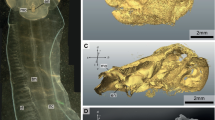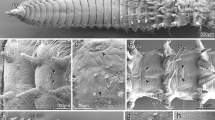Summary
The funnel-canal organs on the dactyls of the shore crab, Carcinus maenas, are innervated by 3–24 sensory cells with unbranched dendrites, which attain a length of 500–1400 μm. The outer dendritic segments are enclosed in a dendritic sheath and pass through the cuticle within a canal. Two dendrite types can be distinguished according to ultrastructural criteria: Type I has a long ciliary segment, A-tubules with an osmiophilic core and arms, and a thick ciliary rootlet. Type II possesses only a short ciliary segment and a thin ciliary rootlet. Each funnel-canal organ contains two type-I dendrites. Their ciliary bases appear a few μm distal to those of the type-II dendrites (1 to 22 in number). Two inner and two to eight outer enveloping cells belong to a sensillum. The innermost enveloping cell contains a large scolopale. In the second enveloping cell single scolopale rods are present. Thus, the funnel-canal organs are characterized by structural features typical for mechano-sensitive scolopidia, on the one hand, and for chemoreceptors, on the other. Therefore, the funnel-canal organs are very likely bimodal sensilla (contact chemoreceptors). A comparison with other arthropod sensilla shows that cuticular mechanoreceptors of aquatic crustaceans generally exhibit a ‘scolopidial’ organization.
Similar content being viewed by others
References
Ache BW (1982) Chemoreception and thermoreception. In: Atwood HL, Sandeman DC (eds) The biology of crustacea Vol. 3. Neurobiology. Acad Press, New York, pp 369–398
Altner H, Prillinger L (1980) Ultrastructure of invertebrate chemo-, thermo-, and hygroreceptors and its functional significance. Int Rev Cytol 67:69–139
Altner I, Hatt H, Altner H (1983) Structural properties of bimodal chemo-and mechanosensitive setae on the pereiopod chelae of the crayfish, Austropotamobius torrentium. Cell Tissue Res 228:357–374
Andersson A (1975) The ultrastructure of the presumed chemoreceptor aesthetasc “Y” of a cypridid ostracode. Zool Scripta 4:151–158
Ball EE, Cowan AN (1977) Ultrastructure of antennal sensilla of Acetes (Crustacea, Decapoda, Natantia, Sergestidae). Phil Trans R Soc (Lond) B 277:429–457
Barth FG (1971) Der sensorische Apparat der Spaltsinnesorgane (Cupiennius salei Keys. Araneae). Z Zellforsch 112:212–246
Barth FG (1980) Campaniform sensilla: another vibration receptor in the crab leg. Naturwissenschaften 67:201–202
Barth FG (1981) Strain detection in the arthropod exoskeleton. In: Laverack MS, Cosens DJ (eds) Sense organs. Blackie, Glasgow, London, pp 112–141
Bloom JW, Zacharuk RY, Holodniuk AE (1982) Ultrastructure of the larval antenna of Tenebrio molitor L. (Coleoptera: Tenebrionidae): structure of the blunt-tipped peg and papillate sensilla. Can J Zool 60 (7): 1545–1556
Boo KS (1981) Discontinuity between ciliary root processes and triple microtubules of distal basal body in mosquito sensory cilia. Korean J Entomol 11:5–18
Bush BMH, Laverack MS (1982) Mechanoreception. In: Atwood HL, Sandeman DC (eds) The biology of crustacea Vol. 3. Neurobiology. Acad Press, New York, pp 399–468
Crouau Y (1978) Ultrastructure des phanères spinulés mécanorécepteurs d'un Crustacé Mysidacé souterrain anophthalme. CR Acad Sc (Paris) D 287:1215–1218
Crouau Y (1980) Comparison of a new structure associated with the membrane of a 9+0 cilia of chordotonal sensilla with the central structure of motile cilia and flagella. Biol Cell 39:349–352
Crouau Y (1981) Cytology of various antennal setae in a troglobitic Mysidacea (Crustacea). Zoomorphology 98:121–134
Crouau Y (1982) Primary stages in the sensory mechanism of the setulate sensilla, external mechanoreceptors of a cavernicolous Mysidacea. Biol Cell 44:45–56
Crouau Y (1983) Ultrastructure study of the 9+0 type cilia of insect and crustacean chordotonal sensilla. Generalisation of the hypothesis on the motility of the 9+0 type cilia. J Submicrosc Cytol 15 (1):295–299
Dillon LS (1981) Ultrastructure, macromolecules and evolution. Plenum Press, New York and London
Dumpert K (1978) Spider odor receptor: electrophysiological proof. Experientia 34:754–755
Ernst K-D (1972) Die Ontogenese der basiconischen Riechsensillen auf der Antenne von Necrophorus. Z Zellforsch 129:217–236
Foelix RF, Chu-Wang I-Wu (1973) The morphology of spider sensilla II. Chemoreceptors. Tissue & Cell 5:461–478
Frisch D, Everingham JW (1972) Fine structure of crab olfactory cilia: non-chemical fixation; environmental effects. In: Schneider D (ed) Olfaction and taste IV. Wissenschaftliche Verlagsanstalt, Stuttgart, pp 5–12
Ghiradella HT, Case JF, Cronshaw J (1968a) Structure of aesthetascs in selected marine and terrestrial decapods: Chemoreceptor morphology and environment. Am Zoologist 8:603–621
Ghiradella H, Case J, Cronshaw J (1968b) Fine structure of the aesthetasc hairs of Coenobita compressus Edwards. J Morphol 124:363–386
Ghiradella H, Cronshaw J, Case J (1968c) Fine structure of the aesthetasc hairs of Pagurus hirsutiusculus Dana. Protoplasma 66:1–20
Gnatzy W, Schmidt K (1971) Die Feinstruktur der Sinneshaare auf den Cerci von Gryllus bimaculatus Deg. (Saltatoria, Gryllidae). I. Faden-und Keulenhaare. Z Zellforsch 122:190–209
Gnatzy W, Schmidt M (1982) Sind die Trichterkanalorgane die “campaniformen Sensillen” der Crustaceen? Verh Dtsch Zool Ges: 249
Gnatzy W, Tautz J (1980) Ultrastructure and mechanical properties of an insect mechanoreceptor: Stimulus-transmitting structures and sensory apparatus of the cereal filiform hairs of Gryllus. Cell Tissue Res 213:441–463
Gnatzy W, Weber KM (1978) Tormogen cell and receptor-lymph space in insect olfactory sensilla. Fine structure and histochemical properties in Calliphora. Cell Tissue Res 189:549–554
Gnatzy W, Schmidt M, Römbke J (1984) Are the funnel-canal organs the ‘campaniform sensilla’ of the shore crab Carcinus maenas (Decapoda, Crustacea)? I. Topography, external structure and main organization. Zoomorphology 104:11–20
Guse GW (1978) Antennal sensilla of Neomysis integer (Leach). Protoplasma 95:145–161
Guse GW (1979) Feinstruktur der Aesthetasken von Neomysis integer (Leach) (Crustacea, Mysidacea). Zool Anz (Jena) 203:170–176
Guse GW (1980) Development of antennal sensilla during moulting in Neomysis integer (Leach) (Crustacea, Mysidacea). Protoplasma 105:53–67
Hansen K (1978) Insect chemoreception. In: Hazelbauer HL (ed) Receptors and recognition, B, 5. Chapman and Hall, London, pp 233–299
Hansen K, Heumann HG (1971) Die Feinstruktur der tarsalen Schmeckhaare der Fliege Phormia terraenovae Rob.-Desv. Z Zellforsch 117:419–442
Harris DJ, Mill PJ (1973) The ultrastructure of chemoreceptor sensilla in Ciniflo (Araneida, Arachnida). Tissue & Cell 5:679–689
Harris DJ, Mill PJ (1977a) Observations on the leg receptors of Ciniflo (Araneida: Dictynidae). I. External mechanoreceptors. J Comp Physiol 119:37–54
Harris DJ, Mill PJ (1977b) Observations on the leg receptors of Ciniflo (Araneida: Dictynida). II. Chemoreceptors. J Comp Physiol 119:55–62
Juberthie-Jupeau L, Crouau Y (1977) Ultrastructure des aesthetascs d'un Mysidacé souterrain anophthalme. C R Acad Sc Paris D 284:2257–2259
Keil T (1976) Sinnesorgane auf den Antennen von Lithobius forficatus L (Myriapoda, Chilopoda). I. Die Funktionsmorphologie der “Sensilla trichodea”. Zoomorphologie 84:77–102
Kouyama N, Shimozawa T (1982) The structure of a hair mechanoreceptor in the antennule of crayfish (Crustacea). Cell Tissue Res 226:565–578
Kouyama N, Shimozawa T, Hisada M (1981) Transducing element of crustacean mechano-sensory hairs. Experientia 37:379–380
Laverack MS (1976) External proprioceptors. In: Mill PJ (ed) Structure and function of proprioceptors in the invertebrates. Chapman and Hall, London, pp 1–63
Luther W (1930) Versuche über die Chemorezeption der Brachyuren. Z Vergl Physiol 12:177–205
McIver SB (1975) Structure of cuticular mechanoreceptors of arthropods. Ann Rev Entomol 20:381–397
Mead F, Gabouriaut D, Corbière-Tichané G (1976) Structure de l'organe sensoriel apical de l'antenne chez l'Isopode terrestre Metaponorthus sexfasciatus Budde-Lund (Crustacea, Isopoda). Zoomorphologie 83:253–269
Mill PJ (1976) Chordotonal organs of crustacean appendages. In: Mill PJ (ed) Structure and function of proprioceptors in the invertebrates. Chapman and Hall, London, pp 243–297
Moran DT, Varela FJ, Rowley JC III (1977) Evidence for active role of cilia in sensory transduction. Proc Natl Acad Sci (USA) 74:793–797
Moulins M (1976) Ultrastructure of chordotonal organs. In: Mill PJ (ed) Structure and function of proprioceptors in the invertebrates. Chapman and Hall, London, pp 387–426
Munn EA, Klepal W, Barnes H (1974) The fine structure and possible function of the sensory setae of the penis of Balanus balanoides (L). J Exp Mar Biol Ecol 14:89–98
Ong JE (1969) The fine structure of the mandibular sensory receptors in the brackish water calanoid copepod Gladioferens pectinatus (Brady). Z Zellforsch 97:178–195
Rice MJ (1975) Insect mechanoreceptor mechanisms. In: Galun R (ed) Sensory physiology and behavior. Plenum Press New York, London:135–165
Rieder N (1979) Die Borsten an den Blattbeinen von Triops cancriformis Bosc. (Crustacea, Notostraca) während der Häutungsvorbereitung. II. Die Ultrastruktur der Borsten vom Typ 2 und 3. Zool Anz Jena 202:317–330
Risler H (1977) Die Sinnesorgane der Antennula von Porcellio scaber Latr. (Crustacea, Isopoda). Zool Jb Anat 98:29–52
Risler H (1978) Die Sinnesorgane der Antennula von Ligidium hypnorum (Cuvier) (Isopoda, Crustacea). Zool Jb Anat 100:514–541
Schmidt K (1969) Der Feinbau der stiftführenden Sinnesorgane im Pedicellus der Florfliege Chrysopa Leach (Chrysopidae, Planipennia) Z Zellforsch 99:357–388
Schmidt K (1973) Vergleichende morphologische Untersuchungen an Mechanorezeptoren der Insekten. Verh Dtsch Zool Ges 66:15–25
Schöne H, Steinbrecht RA (1968) Fine structure of statocyst receptor of Astacus fluviatilis. Nature 220:184–186
Schönrock GU (1981) Feinstruktur und Entwicklung der antennalen Sensillen bei Polydesmus coriaceus Porath 1871 (Diplopoda, Polydesmida). Dissertation, FU Berlin
Shelton RGJ, Laverack MS (1968) Observations on a redescribed crustacean cuticular sense organ. Comp Biochem Physiol 25:1049–1059
Siewing R (1960) Zum Problem der Polyphylie der Arthropoda. Z wiss Zool 164:238–270
Strickler JR, Bal AK (1973) Setae of the first antennae of the copepod Cyclops scutifer (Sars): Their structure and importance. Proc Natl Acad Sci (USA) 70:2656–2659
Takahata M, Hisada M (1979) Functional polarization of statocyst receptors in the crayfish Procambarus clarkii Girard. J Comp Physiol 130:201–207
Thurm U (1964) Mechanoreceptors in the cuticle of the honey bee: Fine structure and stimulus mechanism. Science 145:1063–1065
Thurm U, Stedtler A, Foelix R (1975) Reizwirksame Verformung der Terminalstrukturen eines Mechanorezeptors. Verh Dtsch Zool Ges 67:37–41
Whitear M (1962) The fine structure of crustacean proprioceptors I. The chordotonal organs in the legs of the shore crab, Carcinus maenas. Phil Trans R Soc (London) 245B:291–324
Wright BR (1976) Limb and wing receptors in insects, chelicerates and myriapods. In: Mill PJ (ed) Structure and function of proprioceptors in the Invertebrates. Chapman and Hall, London, pp 323–386
Yokohari F (1981) The sensillum capitulum, an antennal hygroand thermoreceptive sensillum of the cockroach, Periplaneta americana L. Cell Tissue Res 216:525–543
Young D (1973) Fine structure of the sensory cilium of an insect auditory receptor. J Neurocytology 2:47–58
Zacharuk RY (1971) Fine structure of peripheral terminations in the porous sensillar cone of larvae of Ctenicera destructor (Brown), and probable fixation artifacts. Can J Zool 49:789–799
Zacharuk RY (1980) Ultrastructure and function of insect chemosensilla. Ann Rev Entomol 25:27–47
Author information
Authors and Affiliations
Rights and permissions
About this article
Cite this article
Schmidt, M., Gnatzy, W. Are the funnel-canal organs the ‘campaniform sensilla’ of the shore crab, Carcinus maenas (Decapoda, Crustacea)?. Cell Tissue Res. 237, 81–93 (1984). https://doi.org/10.1007/BF00229202
Accepted:
Issue Date:
DOI: https://doi.org/10.1007/BF00229202




